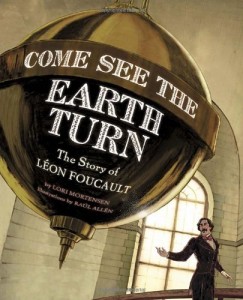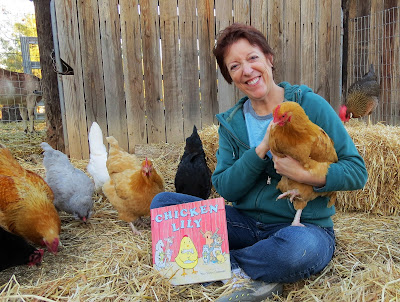
Cowpoke Clyde and Dawg, my favorite picture book duo, are back in another zany adventure. And what an adventure!
Clyde finds an ad in his mailbox from Smedley's Splendid Bicycles that promises fun to the rider. Now, Clyde is used to horses. How can a bicycle be a smart thing to get? But he talks himself into it, considering that a bicycle doesn't require food, doesn't make noise, and doesn't run off on its own.
And it's gotta be easy to ride, right?
Wrong. Clyde and Dawg are in for chills and thrills. The reader is in for lots of laughs. From the illustrations, Dawg's funny bone seems to be tickled as well, although Clyde doesn't find his adventures one bit funny. Illustrator Michael Allen Austin captures the humor, the terror, the
horror, as Clyde rides the range on his out-of-control bicycle, his expressions wildly changing from scene to scene.
I loved this book. It's a great read-aloud. Clyde's "voice" is pitch perfect, as is the narrator's voice. Mortensen's rhyming works beautifully, and I can imagine young listeners chanting along as they listen more than once to this delightful book. Dawg is so doggone doggie, you'll want take him home.
This was a great follow-up to Mortensen's first Cowpoke Clyde book,
Cowpoke Clyde and Dirty Dawg. (I reviewed it on my blog two and a half years ago
HERE.)
You can buy
Cowpoke Clyde and Dirty Dawg at Amazon
HEREYou can buy
Cowpoke Clyde Rides the Range HEREI certainly hope there is a third Cowpoke Clyde book in the works!
More information about where and how to buy these books and the books below can be found on Lori's WEBSITE HERE. Visit the site, too, to read more reviews of these books. |
| Add caption |
Check out two other rhyming picture books by Lori Mortensen: In the Trees, Honey Bees (it's won all kinds of awards), as well as the award-winning Cindy Moo, and a non-rhyming biography about Léon Foucault, Come See the Earth Turn.
 |
| Foucalt's Pendulum' |
 |
| Hey, diddle-diddle. |
 |
Find out about the secret
life of bees. |

By
Lori Mortensenfor
Cynthia Leitich Smith's
CynsationsAfter judging nearly a thousand entries for recent writing contests, I’m reminded once again of the importance and power of effective opening hooks.
Start out swinging, and readers can’t wait to read more. Meander around and readers will quickly lose interest.
The truth is, authors have mere seconds to capture an editor’s heart.
So what makes an effective opening hook?
Start with originality. As I read hundreds of manuscripts, I was amazed at the number of people who wrote about nature’s beauty, but barely skimmed the surface by settling on general ideas about flowers, trees, mountains, rivers, etc.
Nature can be a grand subject, but to rise above the piles of other manuscripts out there, your voice and unique point of view needs to shine from the beginning. So dig deeper and look inside. What unique conclusions have you drawn about something that could be shaped into an original theme?
If you want to capture an editor’s heart, don’t send them macaroni and cheese. Send them Banana Foster Flambé.
My upcoming picture book
Chicken Lily, illustrated by
Nina Victor Crittenden (Henry Holt 2016) is a good example of a story with an effective opening hook.
Instead of opening the story with any old chicken that lived on a farm, I created a unique character with distinctive characteristics.
Chicken Lily was a lot of things . . .
a careful colorer,
a patient puzzler,
and the quietest hide-and-seeker.
She never made a peep.
But Lily was also something else . . .
Because the opening is fresh, focused, and unique, readers want to keep reading to find out more.
In this instance, Chicken Lily is . . . chicken! Raise her hand in class? Forget it! Eat something new for lunch? No way! Chicken Lily is a fun, unique character in the barnyard of children’s literature.
Next, tighten your story so it fits together like a puzzle. This is especially important for the opening hook. Authors that settle for easy, obvious rhymes, or use multiple paragraphs to say what they could have said in one paragraph, will quickly lose readers’ interest. Let your drafts run wild, but when you’re ready to submit, your opening hook should reflect a fresh and focused manuscript.
My upcoming picture book,
Cowpoke Clyde Rides the Range, illustrated by
Michael Allen Austin (Clarion, 2016) is a good example of a strong, rhyming opening hook.
Cowpoke Clyde poked at an ad.
“Looky, Dawg, at this here fad.
It says that when my chores are done,
I’m s’posed to ride a bike fer fun.”
In four short lines, the reader meets a unique character, Clyde, a cowpoke who is going to learn to ride a newfangled bicycle. Each line makes sense, each word has a reason to be there, and the rhyme reads effortlessly.
(How to create fresh, effortless rhymes is another story, but if you want a successful manuscript, don’t settle for less.)
So if you’re scratching your head over a manuscript, take a look at your opening hook. Does it make you want to keep reading or, wonder what’s in the fridge?
Hmm . . . macaroni and cheese? Or Banana Foster Flambé?
Cynsational Notes Lori Mortensen is an award-winning children’s book author of more than 70 books and over 350 stories and articles.

Upcoming titles include
Mousequerade Ball, illustrated by
Betsy Lewin (Bloomsbury) and
Cowpoke Clyde Rides the Range, a sequel to
Cowpoke Clyde & Dirty Dawg, one of Amazon’s best picture books of 2013.
Other titles include
Cindy Moo, illustrated by
Jeff Mack (HarperCollins),
Come See the Earth Turn – The Story of Léon Foucault, illustrated by Raúl Allén (Random House), a Smithsonian Notable Book for Children, 2010, and
In the Trees Honey Bees! illustrated by
Cris Arbo (Dawn), a 2010 NSTA/CBC Outstanding Science Book K-12 Winner.
When she’s not removing her cat from her keyboard, she follows her literary nose wherever it leads and works on all sorts of projects that delight her writing soul. Lori lives with her family in Northern California.
By Tina Vasquez, for The Children’s Book Review
Published: December 5, 2010
 Come See the Earth Turn: The Story of Léon Foucault
Come See the Earth Turn: The Story of Léon Foucault
By Lori Mortensen (Author), Raul Allen (Illustrator)
Reading level: Ages 7-9
Hardcover: 32 pages
Publisher: Tricycle Press (September 14, 2010)
Source: Publisher
In Come See the Earth Turn we immediately learn that physicist Jean Bernard Léon Foucault was special from the very beginning, but not in the way you might think. He was a small, sickly baby who turned into an introverted, slow-moving boy and because of his rocky start in life, many were surprised by his talent for building clever and inventive contraptions. At the urging of his mother, Léon enrolled in medical school with the hope of fulfilling his mother’s dream for him to become a surgeon, but the profession did not sit well with Léon and he eventually dropped out. It wasn’t a total waste however, because it was in the labs at his school that the young man discovered his true passion: physics.
As young readers will learn in Come See the Earth Turn, there are many reasons Léon is an important part of history. Not only was he the first person to photograph the sun, but he was also the first to accurately measure the speed of light. His most important discovery; however, was the result of a happy accident in his laboratory and it once and for all proved that the earth spins on an axis, a claim that had been disputed for years by scholars, scientists, and other educated people of the time.
Part history lesson and part children’s book, Come See the Earth Turn puts complicated science into its simplest terms and sheds light on how Léon created his world famous Foucault pendulum, an invention that would prove to the general public and his critics that the earth rotated.
Young readers will find the realistic illustrations captivating, while also learning the story of Léon Foucault, an unlikely genius.
Add this book to your collection: Come See the Earth Turn















